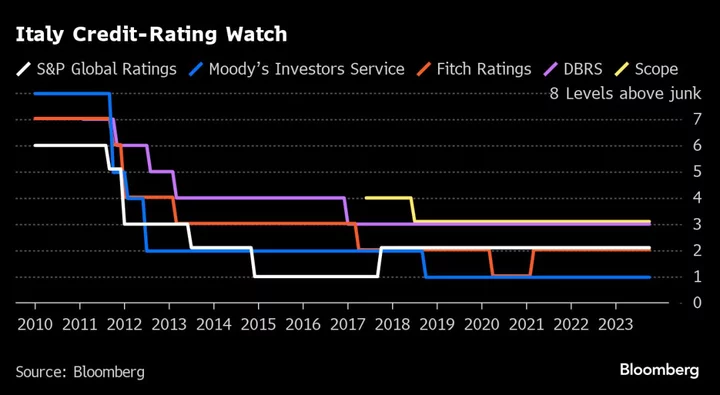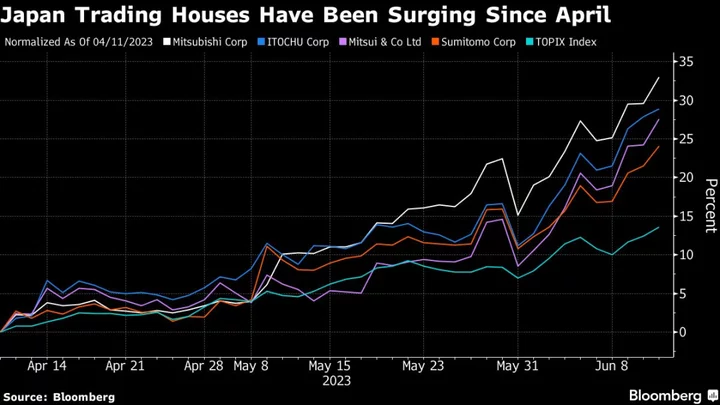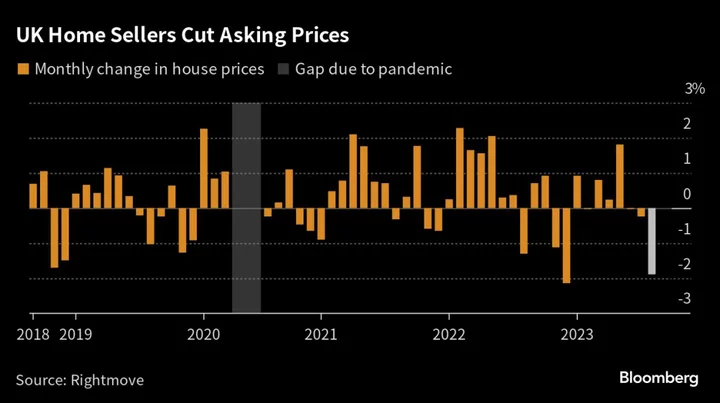North Korea’s newest long-range missile increases the chances it could deliver a strike to the US mainland, giving Kim Jong Un more leverage in his dealings with the Biden administration.
The Hwasong-18 solid-fuel intercontinental ballistic missile North Korea launched this week flew longer than any of its other ICBMS and appeared designed to carry a multiple nuclear weapons payload, which increases the chances at least one bomb could slip past interceptors and make its way to a target.
Video released by North Korea of the Hwasong-18 appeared to show the missile had the ability to stabilize itself in flight, which indicates it could be designed to hold multiple warheads, according to an analysis from George William Herbert, an adjunct professor at the Middlebury Institute of International Studies.
North Korea said in April when it launched the missile for the first time that Pyongyang intended to use it for multiple warheads. The test this week seems to hint at the missile having a MIRV carrier, said Herbert, referring to a multiple warhead carrier technically known as a multiple independently targetable reentry vehicle, or MIRV.
“The second flight apparently going off well shows that it’s a generally successful design, not just a one-off lucky test,” he said.
North Korea released videos of the test on state TV, showing the missile emerging from its canister and being raised into position for a launch. Footage contained shots taken from different angles by multiple cameras, including one from a drone flying overhead that narrowly missed being struck by the passing rocket.
The missile that has been launched twice this year is an improvement from the ICBMs Kim tested in 2017 that raised global concern. Weapons experts said the ICBMs back then were capable of carrying a single bomb and were liquid-fueled, which made them vulnerable to attack before launch as it took time to fill their engines with propellant on the pad.
Solid-fuel missiles have the propellants baked into rockets, allowing them to stay hidden from spy satellites, rolled out and fired in a manner of minutes, giving the US less time to prepare for interception. The challenge becomes even greater if the missile carries several warheads instead of one.
Still, it’s unclear whether the ICBMs could beat antimissile systems and whether the warheads could survive reentry into the atmosphere to reach their targets.
Kim’s ability to deliver a credible nuclear strike on the US could reduce the chances Washington would attempt a preemptive strike on his regime and raises the stakes for what must be offered to entice him to wind down his arsenal.
The success of the Hwasong-18 launches has been a remarkable achievement coming from a country that had a lack of experience with large, multistage solid-propellant missiles prior to these tests, according to Ankit Panda, a senior fellow in the nuclear policy program at the Carnegie Endowment for International Peace.
“Just how North Korea has managed to attain this stunning level of success with its solid-propellant ICBM remains a mystery, but Kim Jong Un will have few complaints,” Panda wrote in an analysis for NK Pro.
Both Hwasong-18s were conducted from the same site in the Pyongyang area, which could raise questions about its ability to be transported by road, Panda said. He added that the site may have been chosen because it’s near one of Kim’s mansions, making it a comfortable venue for the leader.
Kim oversaw the latest test and warned the US and South Korea more were on the way unless they stepped back their military operations that included bringing more American nuclear assets into the region. His state has also threatened to shoot down US spy planes, which last happened in 1969, killing 31 people on board.
As a part of this strategy, Pyongyang appears to be working on silo-based ballistic missiles and missiles that can carry multiple warheads, said Joost Oliemans, a weapons expert who co-authored the book The Armed Forces of North Korea. This could increase the ability to launch a retaliatory strike.
North Korea has also rolled out and tested in recent months its Hwasong-17. It is a liquid-fuel rocket considered by weapons experts to be the world’s largest road-worthy ICBM and could carry a payload of three nuclear bombs.
North Korea has been working for years to miniaturize its warheads, which would allow them to be used in a variety of weapons systems. Kim visited a warhead facility in March and an analysis of what was presented to the leader from the Open Nuclear Network indicated progress.
Warheads shown by North Korea before 2023 had a maximum diameter of 600 millimeters, while its new Hwasan-31 nuclear warhead, shown in photos from Kim’s visit, has a reduced diameter of around 460 mm that suggests advances in miniaturization, it said.
The device has not been tested, but satellite imagery of the site North Korea has used for all six of its previous detonations of nuclear devices indicate the facility has been ready for more than a year.
Russia and China, which have veto power on the United Nations Security Council, allowed sanction to go forward to punish Kim for tests of ballistic missiles in nuclear devices in 2017 but have blocked new punishments on Pyongyang for its recent series of nuclear-capable rockets as friction with the US has increased.
“There were few, if any, consequences to the missile tests. So the question is, how severe will the consequences be for Kim if he were to conduct a seventh nuclear test?” said Soo Kim, a former Korea analyst at the US Central Intelligence Agency who now works at US-based management consulting firm LMI.









